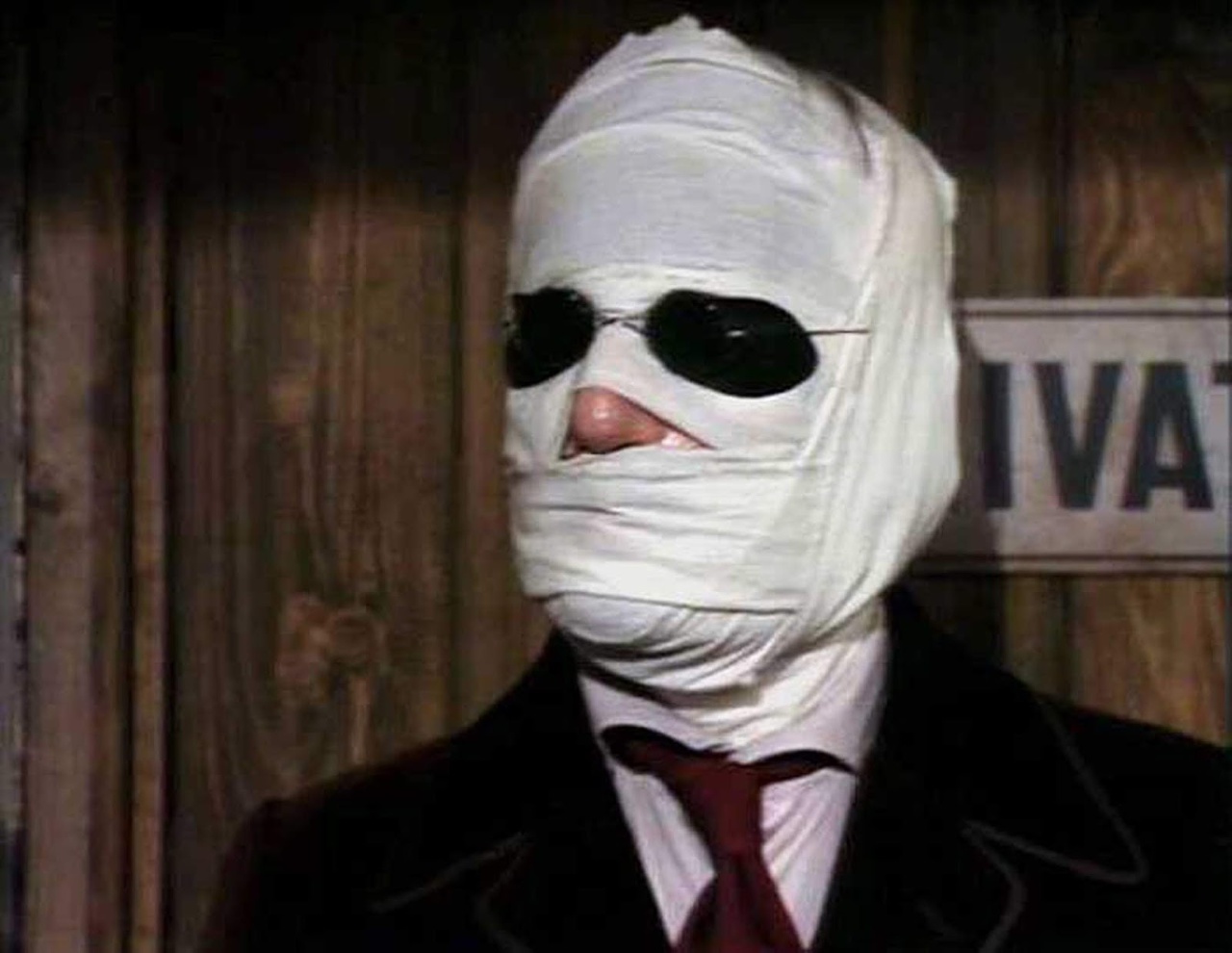UK. 1984.
Crew
Director – Brian Lighthill, Teleplay – James Andrew Hall, Based on the Novel The Invisible Man (1897) by H.G. Wells, Producer – Barry Letts, Music – Stephen Deutsch, Visual Effects Design – John Brace, Designer – Don Giles. Production Company – BBC.
Cast
Pip Donaghy (Griffin), David Gwillim (Samuel Kemp), Lila Kaye (Mrs Hall), Ron Pember (Mr Hall), Gerald James (Dr William Cuss), Michael Sheard (Reverend Bunting), Frank Middlemass (Thomas Marvel) John Quarmby (Constable Jeffers), Donald Bisset (Professor Hobema), Frederick Treves (Colonel Adye), Bernard Stone (Shop Owner)
Plot
A man with his body and face covered in a coat, hat, bandages and dark glasses takes a room at the inn in the village of Iping. The innkeepers and locals find his manner curt and rude. As the man has books and chemicals delivered and stays in his room conducting experiments, there is much speculation by the locals about what he is doing. When he fails to pay rent, they go in to confront the man whereupon he strips off his clothing and bandages to reveal he is invisible. He flees, mocking their attempts to capture him. Wounded, the invisible man seeks refuge with Dr. Samuel Kemp. He reveals that he is Griffin, a former classmate and friend from their student days. He was experimenting with a serum and eventually succeeded in making himself invisible, although soon began to discover a downside to this. As Griffin begins talking of creating an invisible reign of terror, Kemp realises that the serum has caused Griffin to become maddened.
The Invisible Man (1897) is one of the classic novels from H.G. Wells (1866-1946). Wells wrote it in the prolific period at the end of the 1890s nestled in between other classic works like The Time Machine (1895), The Island of Dr Moreau (1896) and The War of the Worlds (1898).
There have been a great many films with some variant on The Invisible Man in their title, ranging from the recent The Invisible Man (2020) to the tv series’ The Invisible Man (1958), The Invisible Man (1975) and The Invisible Man (2000-2). The surprise is that in all of this there has only been one other actual adaptation of the H.G. Wells novel with Universal’s The Invisible Man (1933) starring Claude Rains as Griffin. Even then, H.G. Wells did not approve of director James Whale’s light-hearted approach to the material. All the other Invisible Man films are either sequels featuring some descendent of Griffin or else create an entirely different character. More recently, there was Fear the Invisible Man (2023), which was based on the Wells novel but conducted substantial changes.
This was an adaptation made as a TV Mini-Series for the BBC in six half-hour episodes. It is the only other version of the story beside the 1933 film to return to the book and directly adapt what Wells wrote. It does so far more faithfully that the 1933 film and copies Wells on all the plot beats of the book and in giving life to the minor characters. It is also the only version of the story to take place during the Victorian Gaslight era. This version was made by several of the people behind the BBC’s Doctor Who (1963-89) of this era – producer Barry Letts and script editor Terrence Dicks.

The mini-series wheels into place the considerable resources of the BBC during the day. There is a great flavour of authenticity evinced when it comes to the placid countryside setting of the village of Iping, its inn and the very provincial locals. The mini-series largely avoids the comedy approach that so irked Wells with the 1933 film, apart from the odd scene with the Invisible Man running around the village tripping up locals and knocking the constable into the stream. In particular, the show finds its feet in the last two episodes when it flashes back to showing Griffin conducting his experiments, his efforts to get clothes and the increasingly maddened state of mind he reveals to Kemp (David Gwillim).
The mini-series format does mean the story is paced out – by the end of Episode 1, the most we get of any invisibility is Pip Donaghy peeling open the bandages surrounding his face to reveal it is hollow inside. For the bulk of the series, the invisibility is created through physical effects – armless sleeves, objects levitating on wires and actors pretending to be punched or wrestle with someone who is not there – which are modestly conveyed and with a lack of ostentatious flashiness.
The bulk of the optical effects work doesn’t come until Episode 5 where we see effects of Griffin sitting in a dressing gown eating chicken and especially of the scenes with first a cat and then Griffin progressively turn invisible in a series of lap dissolves from the skin to sinew and then the skeleton. The only scene the series seems to avoid no doubt due to the complexity of effects is when Griffin talks about leaving an outline when he is walking in the rain.
Full mini-series available here

